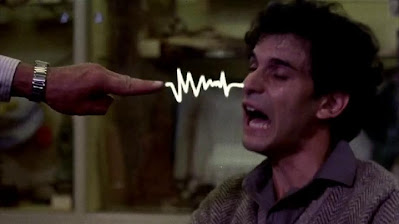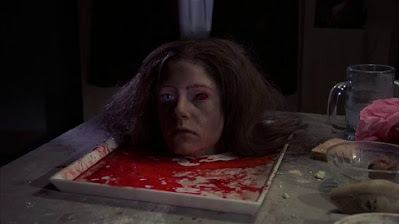... aka: Lips of Blood
... aka: Love Brides of the Blood Mummy
... aka: Perversions sexuelles
... aka: Sang des autres, Les
... aka: Secret of the Egyptian Mummy
Directed by:
Alejandro Martí
James Barton (Frank Braña), who claims to be an Egyptologist interested in studying mummies, is headed to the Dartmoor Castle because it's rumored that the Count ("Jorge" / George Rigaud) has a few in his collection. When James stops to ask for directions, an old farm lady warns him that many young ladies have disappeared inside the castle and others who've returned have lost their minds. Undeterred, James continues on his journey. When he walks in on Count Dartmoor, he's greeted with the stranger sight of him whipping a mummified hand he has nailed to the wall. Dartmoor reveals that he's into the occult, can read minds, knows James isn't who he claims he is and threatens that he'll turn him into a statue if he gives him any trouble. Dartmoor quickly demonstrates his powers by transforming a piece of kindling into a deadly snake and tells James that he'll determine what he's going to do with him at a later time. But first, he wants to share a story about what happened there that will explain the disappearances that have plagued the area.
Two months earlier, Dartmoor had purchased a sarcophagus from the Valley of the Kings. When he and his faithful servant John opened it up, they discovered that the mummy inside wasn't your usual decayed corpse wrapped in dusty bandages, but a perfectly preserved Egyptian man. Dartmoor deciphered some hieroglyphics found on a manuscript alongside the body that revealed the man was the rogue son of a priest who'd had his tongue cut out and was sentenced to death. Using a combination of copper and zinc injected directly into the Egyptian's bloodstream, the Count revived him... but he wasn't interested in his offer of milk to quench his third. This guy wanted fresh human blood... and naturally only the blood from young and attractive women would suffice because that's all monsters in these kind of things are ever interested in. The Egyptian locked Dartmoor up the dungeon, hypnotized John and sent him out to fetch ladies for him to feast on. Dartmoor's daughter Lucy (Catherine Franck) and her friend Anna (Teresa Gimpera) eventually stopped by for more of the same.
The bulk of this movie consists of a succession of boring, repetitive scenes of John acquiring victims and dragging them back to the castle. As was customary with many of these European films, the death scenes were shot two different ways: "clothed" for release in stricter markets and "unclothed" for the "continental" release. The version I watched (a Spanish VHS release on the Video Service, S.A. label) was the "clothed" one, which features the ladies being stripped down to their bloomers and nightgowns before being killed. In the other version they're stripped nude. Interestingly, even in the "clothed" version there's some brief topless shots that make their way in at the very end when a character has a nightmare recalling the events. The whole thing really seems like it's trying to appeal to the bondage crowd. The female victims are kidnapped, shackled, tied up, whipped, branded and slapped around in the dungeon, and there are long takes of the Egyptian wrestling and trying to subdue them that go on forever.
The framework featuring Rigaud (who narrates the flashback footage) and Braña ends with the Egyptian's hand (which had been chopped off with an axe) returning to life and seeking revenge. These scenes (as well as the piece-of-wood-turning-into-a-snake bit) employ some primitive and poorly-executed stop-motion animation.
Aside from any nudity found in the uncut version, the only other thing this has going for it is the shooting locations. It was filmed during the Autumn and the outdoor scenery is lovely. There are lots of colorful trees, fields of tall wheat blowing in the wind and some nice shots along the ocean. The director, who seems obsessed with both shooting reflections of people in water and horse riding, has a nice eye for landscapes. Too bad the rest of this sucks. Despite being shot with sound and in color, it strangely utilizes stylistic choices right out of the silent era. There isn't much dialogue and the scene transitions are done by closing the shutter on the camera!
It was originally released to U.S. theaters (the "clothed" cut, of course!) under the title Love Brides of the Blood Mummy, where it was double-billed with The Secret Love Life of the Invisible Man (which was released on VHS in the U.S. as The Invisible Dead). Since then, it has failed to receive an official DVD or VHS release here. The fact it's not very good coupled with the fact the director is unknown and it doesn't have any 'name' in the cast, probably has a lot to do with that.
★1/2













































































